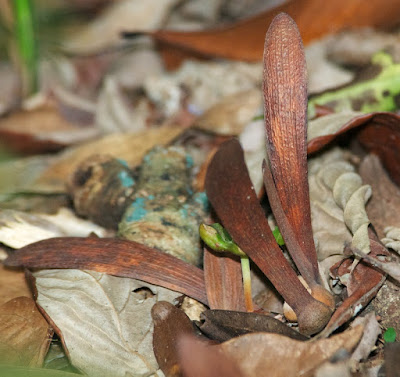With us on the trail were two of Cynthia's friends, Lim Cheng Puay and Chia Ming Huei. They knew quite a lot about the plants and animals we saw on route, were good at spotting things, and made the whole trip very interesting indeed - so much so that it will take me three entries to write it up. This entry looks at the botanical delights we encountered en route.
The Central Catchment, Singapore's largest nature reserve, preserves a remnant of the dipterocarp forest that once covered the island. The forest here is not pristine; in fact much of it was once a rubber plantation, and scattered rubber trees (Hevea brasiliensis) still betray its past. Its future is uncertain - there are plans to build an MRT line under the forest here, and green groups in Singapore are already mobilizing about it.
Dipterocarps (Family Dipterocarpaceae) are magnificent trees, including among their number the tallest tropical trees in the world. They are found throughout the world's tropics, but in Southeast Asia they dominate the tropical rainforest.
The name "dipterocarp" refers to their winged, dry, and often surprisingly large fruits.
Many dipterocarps, instead of flowering every year, indulge in mass seed production every few years. This was one of those years, and the forest floor along the trail was carpeted with their fruits. Others, like this apparently-unripe one, dangled from the vegetation.
Strictly speaking, the fruit falling from trees named "dipterocarp" should have only two wings, and many of the fruits we found lying among the leaf litter lived up quite exactly to the family name. The second one, with the large flaps surrounding the main body of the fruit, is apparently Dipterocarpus sublamellatus.
Others, though, carried three, four or even more. These may have fallen from a meranti (Shorea sp.), a tree prized (unfortunately for the rainforests of much of Asia) for its timber.
Dipterocarps were not the only trees sending their fruits to the forest floor. These strange, flattened seeds fell from another forest giant, the Tualang (Koompassia excelsa), a member of the pea family (Fabaceae). Like the dipterocarps, Tualangs flower only every few years.
Ming Huei pointed out the odd, trifid fruits of a Kokoona tree, a member of the Celastraceae known in the timber trade as Mata Ulat, high above us. We found others on the forest floor. The species is presumably either K. reflexa (listed as Critically Endangered in Singapore) or K. malaccensis.
We found a range of other fruits, too - some with their own parachutes that delivered them gently to the ground, others that - at least their shape suggests it - simply plummeted from the treetops.
Where there are fallen fruits there will be seedlings, and indeed we found them everywhere, sprouting from the leaf litter (the second photo shows a sprouting Koompassia).
Of course, not all interesting forest trees reach into the canopy. The members of the genus Macaranga, common along the forest edge, include some very interesting plants indeed. The Common Mahang (Macaranga bancana) has evolved a special relationship with ants of the genus Crematogaster. The most obvious signs of this relationship (other than the ants themselves) are the black swellings at the bases of the leaves - specialized glands that produce ant food, in the form of small white starch bodies. The ants burrow into the plant, hollow out its stem, and live inside, swarming out to spray intruders with formic acid. The relationship goes further, involving scale insects and the caterpillars of oakblue butterflies (Arhopala spp.) - follow the link above to see the details.
I have no idea what this is, but I think its clusters of flowers are quite lovely.
Besides the dry, winged structures volplaning down from the canopy, he forest was full of fleshy fruits of one sort or another.
They, too, fall to the forest floor, sometimes in clusters as here.
These appear to be the fruits of a common forest climber, the Mandarin Orange Fig (Ficus punctata).
This is also a fig, but an arborescent one - its fruits sprouting directly from the trunk, a common growth habit of tropical fig trees.
Along with the burgeoning new life as seeds sprout from the litter, the forest was full of evidence of the other end of the process - from decaying leaves...
...to a range of fungi, their unseen mycelia feeding from decaying wood or the remains of rotting plants.
Bracket fungi of (I assume) various sorts grew from fallen logs.
Others took even odder form (in fact, I'm not even sure that these really are fungi, particularly the odd white crust in the lower photo).
In all, the reserve preserves a cycle of forest life, visible to anyone with an eye to see it. In the next two posts, we'll look the animal life we found as we hiked along its trails.









































No comments:
Post a Comment